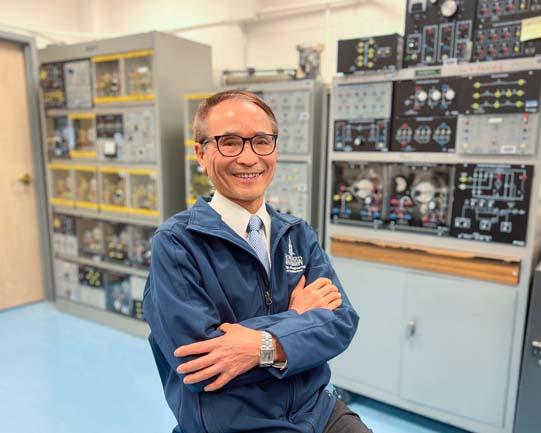Charles Kim, Ph.D., a professor in Howard University’s Department of Electrical Engineering and Computer Science, is leading the way in revolutionizing power system reliability with his invention of the Brownout Detector. This technology addresses a critical issue in power distribution and demonstrates Howard’s commitment to innovation that makes a difference in people’s lives around the world.

Recently, Howard made history by becoming the first and only HBCU to earn R1 status, a prestigious designation that highlights the University’s exceptional research capabilities and groundbreaking contributions to addressing real-world challenges.
The Brownout Detector:
A New Approach to Fault Detection
While the term “brownout” often refers to a temporary voltage drop, Dr. Kim’s Brownout Detector focuses on detecting sub-cycle faults — brief but powerful spikes in currents that occur in electrical cables, both underground and overhead. These faults can be caused by damage to the cables, such as tiny cracks or moisture getting in, and last only a fraction of a second. Although they clear up quickly, these faults can eventually lead to more severe, permanent failures, causing power outages.
Traditional systems were unable to detect these quick faults, but Dr. Kim’s innovation changes that. The Brownout Detector uses current and voltage data to pinpoint exactly where these faults are happening. This early detection allows utilities to repair the problem before it leads to a widespread outage, improving the reliability of power grids and preventing unnecessary disruptions.
Addressing a Longstanding Issue in Power Systems
Power companies have struggled with the issue of sub-cycle faults for years. Most traditional detection methods could not identify these quick faults, leaving power systems vulnerable to sudden failures. Dr. Kim’s breakthrough was to use an inverse approach — measuring the current and voltage to calculate where the faults are occurring in the electrical system. This allows for targeted repairs, preventing outages before they happen.
Dr. Kim’s technology has already been tested with real-world data, showing promising results. The Brownout Detector has been licensed to a data science company that has applied it to predict faults and direct inspections, and it is now being used by major power companies to enhance their systems’ reliability.
A Positive Impact on Public Safety and Power Reliability
The implications of this technology go far beyond technical innovation. By detecting faults early, the Brownout Detector helps utilities avoid unexpected outages, which can be costly and disruptive for businesses, healthcare facilities, and everyday life. For communities that depend on continuous power — such as those with vulnerable populations or critical services — this technology is crucial in preventing major disruptions.
Strengthening Howard University’s Innovation Legacy
The development of the Brownout Detector is a prime example of how Howard University fosters groundbreaking research that serves the public good. Dr. Kim credits the strong support from Howard’s faculty, administrators, and intellectual property office for helping bring his invention to life and to market.
“Howard’s emphasis on intellectual property and innovation has been essential in turning my research into a real-world solution,” Dr. Kim said.
The success of the Brownout Detector is a significant achievement for Howard’s growing research portfolio. The technology’s licensing to a leading company is already making an impact, and it showcases Howard’s ability to produce practical, high-impact solutions to complex global challenges.
Looking to the Future of Power System Safety
While Dr. Kim continues to refine his fault detection technology, his research is also expanding into areas like protecting power systems from cyber threats. As more critical infrastructure becomes connected to the digital world, his work in safeguarding these systems from cyberattacks is poised to be just as impactful.
For now, the Brownout Detector stands as a groundbreaking solution to a critical problem in power distribution. It not only strengthens Howard University’s reputation for innovation but also provides a tangible, life-changing impact for communities around the world. Through continued advancements in technology, Dr. Kim’s work is helping to ensure that the power systems of the future are safer, more reliable, and better equipped to serve the public.
Article ID: 2196




